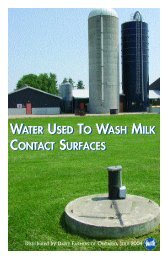Canadian Quality Milk On-Farm Food Safety Program - Centre ...
Canadian Quality Milk On-Farm Food Safety Program - Centre ...
Canadian Quality Milk On-Farm Food Safety Program - Centre ...
Create successful ePaper yourself
Turn your PDF publications into a flip-book with our unique Google optimized e-Paper software.
<strong>Canadian</strong> <strong>Quality</strong> <strong>Milk</strong><br />
• In tie-stalls, install the water bowl over the manger to prevent overflow on the<br />
bedding.<br />
Maintain stalls:<br />
• Keep stalls clean, dry and drainable.<br />
• Clean stalls at least 2 times a day and rake as required to maximize cow<br />
cleanliness, comfort and use.<br />
• Regardless of whether the stall surfaces are concrete, rubber mats or<br />
mattresses, keep them covered with a layer of fresh bedding.<br />
Ensure stall bedding materials are absorbent, comfortable and do not encourage<br />
bacterial growth. Two choices of bedding materials are:<br />
• Organic (e.g. sawdust, shavings, straw, earth).<br />
• Inorganic (e.g. sand, gravel, quarry or limestone dust).<br />
Limit access to manure-cleaning equipment.<br />
Test it: To test stall comfort, kneel down where your cattle have to lie. Rock back and<br />
forth; the surface should be comfortable and cushion your knees. If it hurts your knees to<br />
fall on this surface, your cattle will be reluctant to use this area. If after 10 to 20 seconds<br />
your knees are wet or dirty, udders will get dirty as well. In both cases, bedding<br />
management should be improved.<br />
All cattle should be kept clean to reduce hazards associated with meat safety due to<br />
manure accumulations on hides when the animals are shipped. The best management<br />
practices described above also apply to keeping animals’ hides clean.<br />
1.3.1.2 Exercise Yards and Dry lots<br />
Exercise yards and dry lots are areas that can be a source of manure-based bacteria.<br />
Restrict cattle access to manure and runoff storage by fencing cattle out of these<br />
areas.<br />
Design exercise yards for animal safety and cleanliness. Consider paved or mudcontrol<br />
materials where yards are perpetually wet and where traffic is heavy.<br />
Divert clean water (uncontaminated), such as water from rain, snow, snowmelt, roofs<br />
and eaves before it comes in contact with manure on exercise yard.<br />
Contain contaminated runoff by channeling it (e.g. from stored manure) to liquid<br />
manure storages or to artificial wetlands.<br />
Keep paved areas clean by regularly removing manure to manure storage area.<br />
Maintain forage cover in grassed exercise yards by managing the lot using a<br />
rotational grazing management system.<br />
1.3.1.3 Laneways<br />
Ensure laneway and loading area for milk pick-up are free of manure contamination,<br />
at the time of milk pick-up.<br />
June 2010 1—7
















